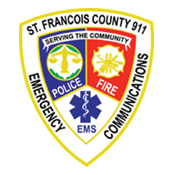”We needed a solution that … gave us the ability to customize scripts and provide flexibility for dispatchers to better meet the needs of our rural population.”
Chuck Farr, Deputy Director St. Francois County (Missouri) 911

Situation
St. Francois County, with a population of 66,922, is located in southeast Missouri approximately 60 miles south of St. Louis. Since 2011, St. Francois County 911 has operated as a Joint Communications Center, located in Park Hills, where it also handles 911 calls for Ste. Genevieve County, population 17,887.
St. Francois County 911 had been using a solution based on flip cards that only covered EMS, and it had no computer integration. The flip card text was inflexible, and oriented toward the needs of a major metropolitan area.
“We needed a solution that supported Police, Fire, and EMS, and something that gave us the ability to customize scripts and provide flexibility for dispatchers to better meet the needs of our rural population,” says Chuck Farr, Deputy Director St. Francois County 911. We had to find a way to better meet the needs of our rural Police, Fire, and EMS organizations and the people they serve.”
Solution
St. Francois County 911 discovered the solution it needed with PowerPhone’s Total Response emergency call handling software. “We were so impressed with the ability to customize Total Response, that at first, we couldn’t believe it until we did it ourselves,” Farr says. As dispatchers work with computer-based Total Response, protocols are instantly refreshed according to caller replies to branching questions. Along the way, the data is fed automatically to the center’s CAD system so first responders have immediate access to the information they need while still enroute.
St. Francois County 911 was surprised by the cost savings compared to their previous flip-card system.
“Looking at the initial cost and ongoing costs, there was a big difference between Total Response and our previous solution. From a cost/benefits standpoint there was no question that Total Response was what we needed.”
St. Francois County 911 has deployed Total Response for all its 10 dispatcher consoles.
Benefits
St. Francois County 911 has enjoyed a number of benefits since deploying Total Response software, including easy customization to meet needs of rural communities, ease of use, providing dispatchers with pre-arrival guidance, CAD integration to deliver information directly to responders, great online training and recertification tracking.
Easily Customized to Meet Needs of Rural Communities Served
While St. Francois County 911 enjoys a number of benefits from their deployment of Total Response, their most valued is the ability to easily tailor questions and protocols to meet the needs of the rural communities they serve. “The biggest selling point for us continues to be that using the Script Manager module of Total Response we can easily alter the questions our dispatchers see for a given situation to better fit our needs,” Farr says. “This is essential because not every 911 center operates in the same way across the nation. Total Response really changed the game for us with the ability to make sure we asked the questions that needed to be asked.”
”We sat down with the Fire Committee and came up with a set of questions to clarify exactly what was burning. We implemented all of this on our own using the Script Manager module of Total Response.”
Chuck Farr, Deputy Director St. Francois County (Missouri) 911
As an example, he points to fielding 911 calls about fires.
“A lot of our area is very rural, and depending on location, it may take the nearest volunteer fire department 20 to 25 minutes to get there,” Farr says. “This means a small brush fire, depending on the season and the wind, could expand in a matter of minutes. Using Total Response, we customized our scripts so the dispatcher asks the right questions such as: How many acres? What is the wind speed and direction? Are there any structures? Are there propane tanks or other hazardous materials?”
This information helps determine the response level.
“We can communicate directly with the Fire Chiefs in the nearest districts and let them know what they are facing and help coordinate the best equipment response,” Farr says.
Another area of customization was for residential fires. The area has many lakeside areas for camper trucks and RVs. With the old system, there were no questions to differentiate between an RV being on fire, or someone’s house.
“We had to do something because we were sometimes sending five fire departments and 10 trucks to a 31-foot camper that’s burnt up by the time anybody gets there, while we would otherwise send a single fire department with one or two trucks,” Farr says. “We sat down with the Fire Committee and came up with a set of questions to clarify exactly what was burning, which we implemented using the Script Manager module.”
The 911 Center also customized questions used in fielding EMS calls. “Our previous solution assumed a metropolitan area where trauma centers are just minutes away,” Farr says. “In our rural area the nearest trauma center is 45 minutes away. We were able to create questions that provided a clearer picture for the dispatcher and the responders of what was needed, including whether to spin up a helicopter for patient transport.”
Ease of Use Removes Stress for Callers and Dispatchers
Total Response, with its intuitive user interface, and automated branching of questions, is so easy to use that Farr says, “Someone could sit down with it for just a few minutes and be able to use it.”
The intelligent branching of questions as a dispatcher clicks through questions on the screen is a welcome relief from the days of trying to keep your place with flip-cards while typing information into the CAD system.
“Nothing was worse than turning away from the cards to answer the radio or speak with another dispatcher, and then losing your spot on the card and repeating a protocol you had already done, or perhaps skipping over something vital,” Farr says. “This doesn’t happen with Total Response because you are working from the screen and can always see exactly where you left off.”
The natural branching of questions makes for a better experience on both ends of the phone call because the dispatcher can swiftly drill down into the exact needs of the caller and can often begin the dispatch after just one or two questions, while continuing to gather additional information from the caller. Total Response frees both caller and dispatcher from having to wade through non-relevant questions.
“People don’t call 911 on their best day,” Farr says. “They’re calling 911 on what might be the worst day of their life. The faster they can provide their information and know that help is on the way, the better.”
The ease of use, and speed with which Total Response helps dispatchers make decisions helps remove stress from dispatchers as well.
“Working with Total Response gives our dispatchers the peace of mind that they have this powerful tool that aids them in performing their job,” Farr says. “The branching questions of the screen help them rapidly drill down into the situation, with all the data being immediately sent to the responders because Total Response is integrated directly into our CAD system.
Our dispatchers can see how they are making a difference for the person in need, and how they are helping prepare whoever is on the way to help.”
Giving Dispatchers Pre-Arrival Instructions to Save Lives While Waiting for EMS to Arrive
Farr notes that within an urban environment, EMS might be just two or three minutes away, but in his rural area it may take 25 minutes or more for aid to arrive. This makes his call takers especially grateful for the detailed pre-arrival instructions Total Response provides to help dispatchers coach whomever might be with a victim while waiting for help to arrive.
“Total Response provides step-by-step questions that adjust according to the answers to help dispatchers guide someone through basic first aid while awaiting the responder,” Farr says. “It can guide someone through helping a choking victim, with different guidance for infants, children, and adults. It provides step-by-step guidance for a spectrum of situations.”
“The guidance for CPR is amazing,” Farr says.
“Whether dealing with an adult, child, or infant, it provides step-by-step instructions for the dispatcher to relay to the person trying to help on the other end of the phone. What really stands out to me is that Total Response includes a CPR compression counter to ensure the right timing and rhythm is used. The dispatcher can actually tell the person exactly when to apply pressure, over and over until help arrives.” Such high-quality CPR guidance is especially important for the rural areas they serve.
“As a dispatcher, I’m in my 22nd year, and I can tell you that sitting in front of the Total Response screen guiding someone through CPR, compared with reading them instructions from a flip card is a night and day difference,” Farr says. “To help someone provide the appropriate response while waiting for the responder to arrive is a tremendous feeling. We’re giving our dispatchers the ability to potentially save lives. It’s hard to put a value on that.”
”In our rural area the nearest trauma center is 45 minutes away. We were able to create questions that provided a clearer picture for the dispatcher and the responders of what was needed, including whether to spin up a helicopter for patient transport.”
Chuck Farr, Deputy Director St. Francois County (Missouri) 911
Total Response CAD Integration Delivers Information Directly to Responders
First responders greatly value the real-time information they get because Total Response is integrated with the 911 center’s CAD system.
“We have some agencies, especially the fulltime fire department, that have EMTs. They can better prepare for arrival based on information that’s automatically entered by our dispatchers working with Total Response,” Farr says. “For example, they can see: 62-year-old female with a cardiac history, who’s taken three nitros with no relief. Or they might see that a diabetic has a blood sugar of 22. Or maybe it is a chainsaw accident with arterial bleeding or an amputation, in which case they might ask for immediate dispatch of a helicopter. In our rural area, sometimes the helicopter arrives before the fire truck or ambulance.”
Farr likes that the information is automatically fed into the CAD system. Previously the information had to be typed in separately, which wasn’t always possible when dealing with an emergency.
“Sometimes a dispatcher is too busy trying to keep the person on the other line alive to break away to communicate separately with the responder. The dispatcher might be trying to keep the person awake, or especially if the person is alone, instructing them to apply pressure continuously on their wound. So, making all of this information automatically available to the responders is a real game changer.”
Great Online Training and Recertification Tracking
St. Francois County 911 values the online training provided by PowerPhone Total Response. Their old system required classroom training, which was difficult to schedule, and recertifications involved mailing tests back to the vendor for grading.
“Now we can do everything in house,” Farr says. “With online training, our dispatchers can do this when it best fits their schedule.”
Farr likes the way Total Response automatically tracks certification expiration dates and provides advanced warnings so dispatchers can be sure to recertify without disruption.
“With our previous solution, with paper-based tests that had to be sent back and forth, and no automatic reminders, there was a lot of stress for our dispatchers, especially when certifications lapsed. With Total Response everyone knows when something is due and what needs to be done. Our recertification process is pretty much seamless now.”




